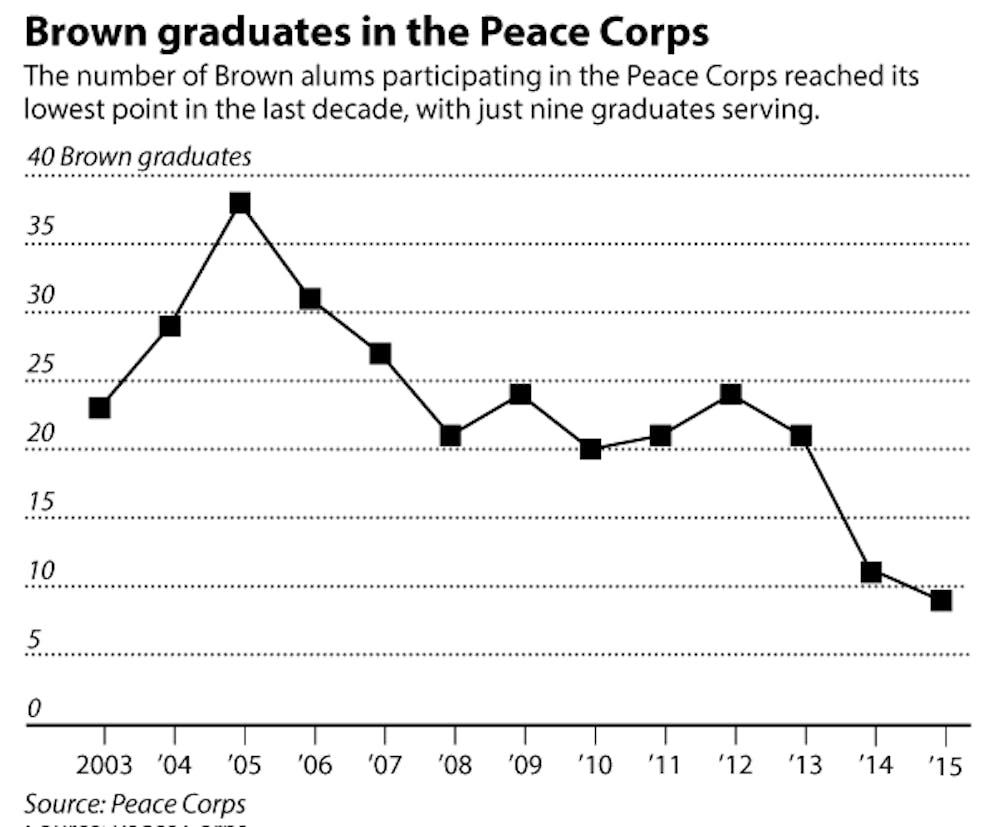For the third consecutive year, Brown failed to make the list of the top 25 medium-sized colleges and universities to send graduates to the Peace Corps. Following more than a decade of maintaining steady placement in the ranking — with between 20 and 38 alums serving each year between 2002 and 2013 — the University’s numbers fell to just 11 last year, and even further to nine in 2015.
Making the list this year would have required the current participation of at least 13 Brown alums in the Peace Corps, a government-funded initiative sending Americans to work in developing countries at the grassroots level, according to its website. For ranking purposes, Brown is included in a bracket with other “medium-sized” schools that have undergraduate populations of between 5,000 and 15,000 students.
Western Washington University topped the medium-sized college ranking, with 47 graduates currently active in the Peace Corps. The only Ivy League schools to make the list were Cornell in fifth place with 33 volunteers and Columbia, which finished in a tie for 24th with 13 volunteers.
Brown alums consistently show a high level of interest in the organization, said Elizabeth Chamberlain, public affairs specialist for the Peace Corps’ Northeast Regional Office. “Brown students are very well informed,” she said. “Most of them have researched (the Peace Corps) so well that they already know the basic facts” before speaking with representatives from the organization.
Students at Brown and other Ivy League and elite universities are seeing more available job and fellowship opportunities right out of college and are feeling pressure to pay off their student debts quickly, Chamberlain added.
“Brown students have a lot of options,” she said. “We’re seeing a lot of students who are very interested in the Peace Corps and are getting offered Fulbright scholarships.”
Kathryn Fidler, Rhode Island’s regional recruiter for the Peace Corps, also said she noticed stable interest from Brown graduates, adding that the current economic climate could dissuade some students from giving up two years of their long-term job search. The recruiting tactics for Brown, she said, are largely identical to those used at other schools and have not changed substantially.
“Whenever possible, I meet one-on-one with the interested student to find out how their personal skill set and academic background would fit in with Peace Corps programs,” she said.
The median age of Peace Corps volunteers is rising, with more potential volunteers entering the workforce for a time before applying, instead of joining right after graduation, Chamberlain added.
Marisa Catalina Casey ’01 served from 2012 to 2014 in Ecuador after working as a photojournalist and starting a nonprofit in the years after leaving Brown. Casey said during her application process, it was apparent that the Peace Corps was extending its recruiting efforts to target those with prior work experience more heavily.
“The median age was right around 28,” Casey said. “Some people had advanced degrees, and they were encouraging retirees and married couples” to apply, she said.
Working prior to joining the Peace Corps equipped Casey with numerous skills that supplemented her volunteer efforts. “I knew how to get funding and write grants, and I could market,” she said, adding that she and her husband were able to “accelerate” the progress of their work in Ecuador as a result.
Though many recent college graduates realize the abundance of opportunities available and the costs of spending two years abroad, some are not aware of how hard the work will be, Casey said. “You’re living at the poverty line. We didn’t have hot water. … You just don’t have those comforts of home.”

ADVERTISEMENT




